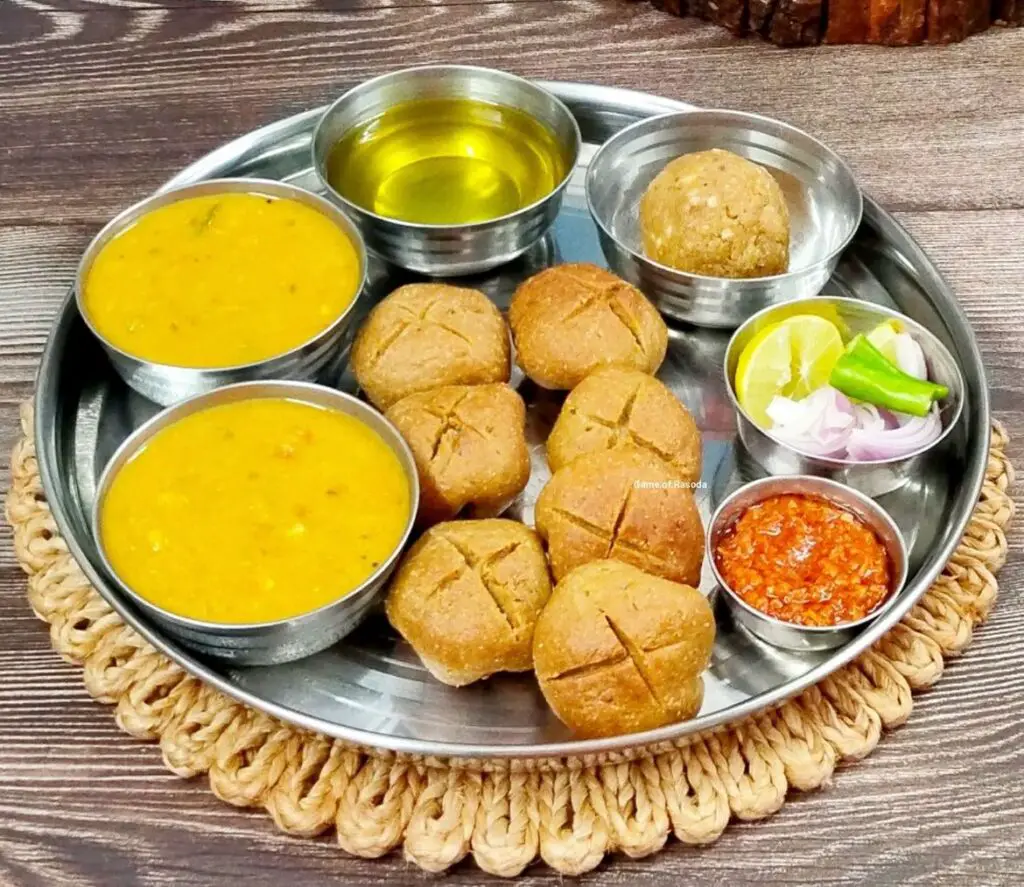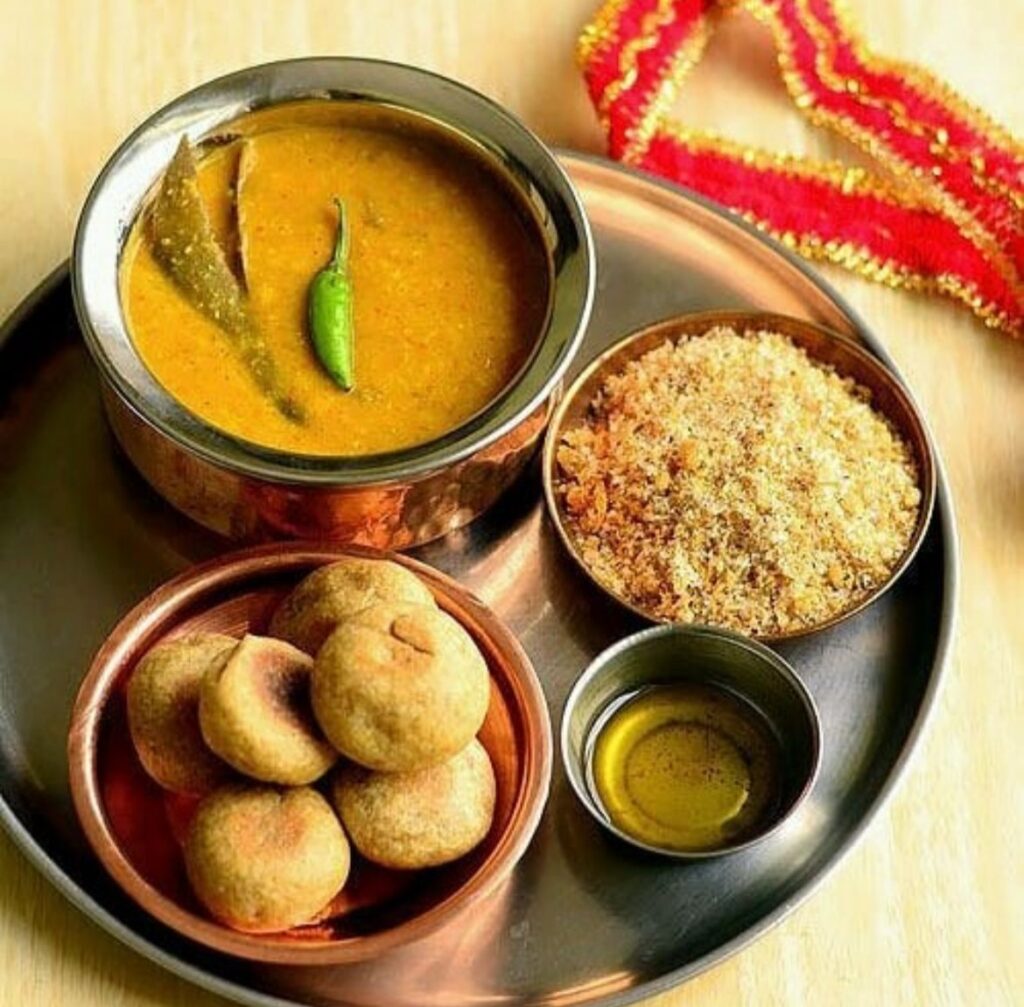Rajasthan, the vibrant land of deserts and royals, is not only known for its rich history and majestic forts but also for its delectable cuisine like Dal Bati Churma . Among the culinary treasures that Rajasthan offers, “Dal Bati Churma” stands as an emblematic trio of flavors that truly define the essence of Rajasthani food culture. Let’s take a deep dive into this iconic dish and explore its elements that together create a symphony of taste and tradition.

Table of Contents
Dal Bati Churma: The Trio of Flavors
1. Dal:
Dal, the quintessential lentil dish, forms the heart of this ensemble. Prepared with a blend of different lentils, aromatic spices, and often a touch of ghee (clarified butter), Rajasthani dal is known for its earthy flavors and nutritional value. This lentil preparation serves as the soul-warming base for the iconic trio.
2. Bati:
Bati is the bread counterpart to the dal, crafted from whole wheat dough. These round dough balls are traditionally baked in a clay oven (tandoor), resulting in a crispy exterior and a soft interior. The art of making perfectly baked batis lies in achieving the right balance between textures, giving a satisfying crunch as you delve into its soft core.
3. Churma:
Churma, the sweet element of the trio, offers a delightful contrast to the savory dal and bati. It is made by crushing or powdering whole wheat dough balls, then combining them with ghee, sugar, and aromatic spices. This blend of textures and flavors creates a dessert-like indulgence that rounds off the meal on a sweet note.
Preparation of Dal Bati Churma: A Labor of Love
The process of crafting Dal Bati Churma involves a blend of culinary skill and cultural tradition. Each element is meticulously prepared to create a harmonious composition of flavors that reflect the ethos of Rajasthan.
Preparing Dal:
To make the dal, a variety of lentils such as moong, masoor, and chana dal are typically used. The lentils are cooked with a medley of aromatic spices like cumin, coriander, and turmeric, resulting in a hearty and flavorful lentil stew. A touch of ghee adds richness to the dish, and the dal is slow-cooked to perfection.
Baking Bati:
The bati, made from whole wheat dough, is a skillful art. The dough is expertly formed into circular balls and then skillfully baked within a time-honored clay oven, known as a tandoor. This baking process imparts a unique smokiness and a crisp exterior to the batis while keeping the inside soft. The batis are often brushed with ghee for an added layer of flavor.
Creating Churma:
Churma is a delightful departure from the savory elements of the trio. The process begins by baking or frying whole wheat dough balls until they are golden brown and cooked through. After cooling, these balls are crushed or ground to create a coarse texture. Ghee, sugar, and aromatic spices like cardamom are added to the mixture, creating a sweet and fragrant churma.
Savoring the Trio: A Flavorful Symphony
When the dal, bati, and churma come together on a plate, it’s a feast for the senses. The bati is traditionally broken into pieces and soaked in the dal, allowing it to absorb the flavors. A bite of the dal-soaked bati, coupled with a spoonful of churma, creates a taste sensation that balances savory and sweet, soft and crispy, creating a harmonious melody of flavors.
Cultural Significance: A Celebration on a Plate
Dal Bati Churma isn’t just a meal; it’s a cultural celebration. It’s often served on festive occasions, weddings, and gatherings, embodying the spirit of togetherness and abundance. The meticulous preparation and time-honored methods behind this dish reflect the values of patience, craftsmanship, and community that are deeply ingrained in Rajasthani culture.
The Experience Beyond Taste:
Dal Bati Churma isn’t just about the flavors; it’s an experience that transports you to the heart of Rajasthan. It’s about indulging in the royal heritage, embracing the simplicity of desert life, and savoring the love and dedication that go into its creation. Whether you’re in the vibrant streets of Jaipur or trying it in your own kitchen, Dal Bati Churma offers more than just a meal—it’s a journey through culture, tradition, and taste.

FAQs about Dal Bati Churma:
Q1: What makes Dal Bati Churma special in Rajasthani cuisine?
A1: Dal Bati Churma is not just a meal; it’s a representation of Rajasthan’s culinary heritage. It embodies the region’s simplicity, resourcefulness, and love for flavors.
Q2: Is Dal Bati Churma a traditional dish?
A2: Absolutely! This dish has been a staple in Rajasthani households for generations, often associated with celebrations, festivals, and special occasions.
Q3: Can I enjoy Dal Bati Churma outside of Rajasthan?
A3: Yes, many restaurants across India offer this iconic trio. However, tasting it in Rajasthan itself adds an authentic touch to the experience.
Q4: What variations exist for Dal Bati Churma?
A4: While the basic components remain the same, there are regional and personal variations in preparation. Some may use different lentils, spices, or techniques, creating a diverse palette of flavors.
Q5: Is Dal Bati Churma a balanced meal?
A5: Yes, it is! The combination of dal’s protein, bati’s carbohydrates, and churma’s sweetness offers a balanced blend of nutrients and tastes.
Q6: Can I try making Dal Bati Churma at home?
A6: Absolutely! While the process can be intricate, there are many recipes available online that guide you through the steps. It’s a wonderful culinary adventure to embark upon.
Q7: What’s the best way to enjoy Dal Bati Churma?
A7: The best way is to savor each element together. Dip a piece of bati into the dal, followed by a bit of churma, and experience the symphony of flavors and textures.
In Conclusion: A Royal Culinary Journey
Dal Bati Churma encapsulates the essence of Rajasthan’s culture and culinary heritage in every bite. Its trio of flavors, rooted in tradition, takes your taste buds on a journey through the arid landscapes and rich history of this royal land. So, whether you’re indulging in it at a local eatery in Rajasthan or recreating it in your own kitchen, Dal Bati Churma promises an experience that’s as rich and diverse as the land it hails from.
For more delicious food : https://spotnews2023.com/index.php/2023/08/17/litti-chokha/
for recipe : https://nishamadhulika.com/58-dal_bati_recipe.html



[…] For more relative blogs: https://spotnews2023.com/index.php/2023/08/17/dal-bati-churma-a-trio-of-delicacies-that-define-rajas… […]
[…] To know more about our blog kindly check:https://spotnews2023.com/index.php/2023/08/17/dal-bati-churma/ […]
[…] to read other food related blog:https://spotnews2023.com/index.php/2023/08/17/dal-bati-churma/ […]